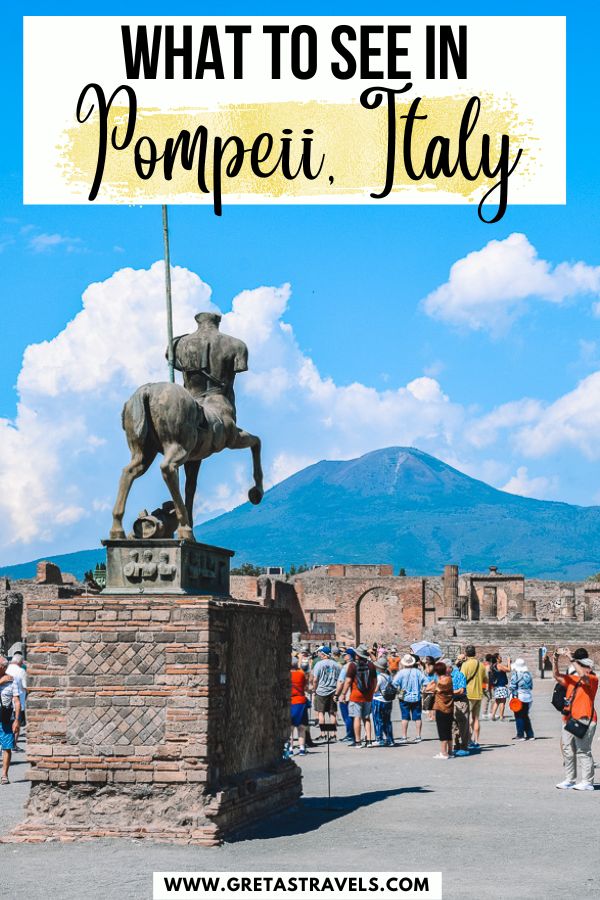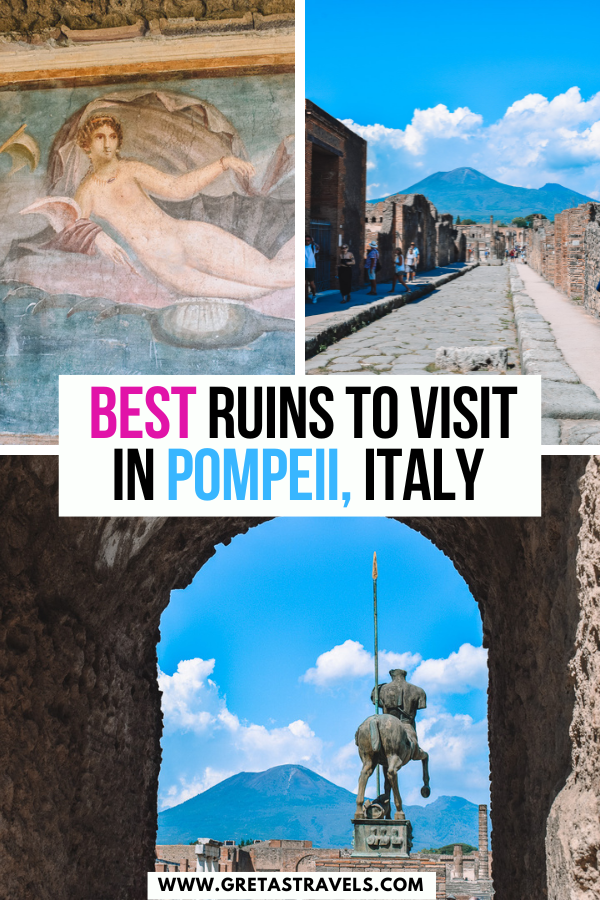Are you planning a visit to Pompeii but unsure where to begin? You’ve come to the right spot!
Pompeii is an expansive archaeological site, spanning over 12 square kilometers. With so much to explore, organizing your visit can feel overwhelming.
How do you choose what to see in Pompeii? Which ruins hold the most historical significance? What parts of this ancient city are absolutely essential to your experience?
In this article, I will provide you with all the answers! Featuring a detailed map of the Pompeii ruins along with insights into the must-visit spots, this guide will help you maximize your self-guided tour of Pompeii.
So why wait? Let’s jump in and begin planning your perfect trip to Pompeii!
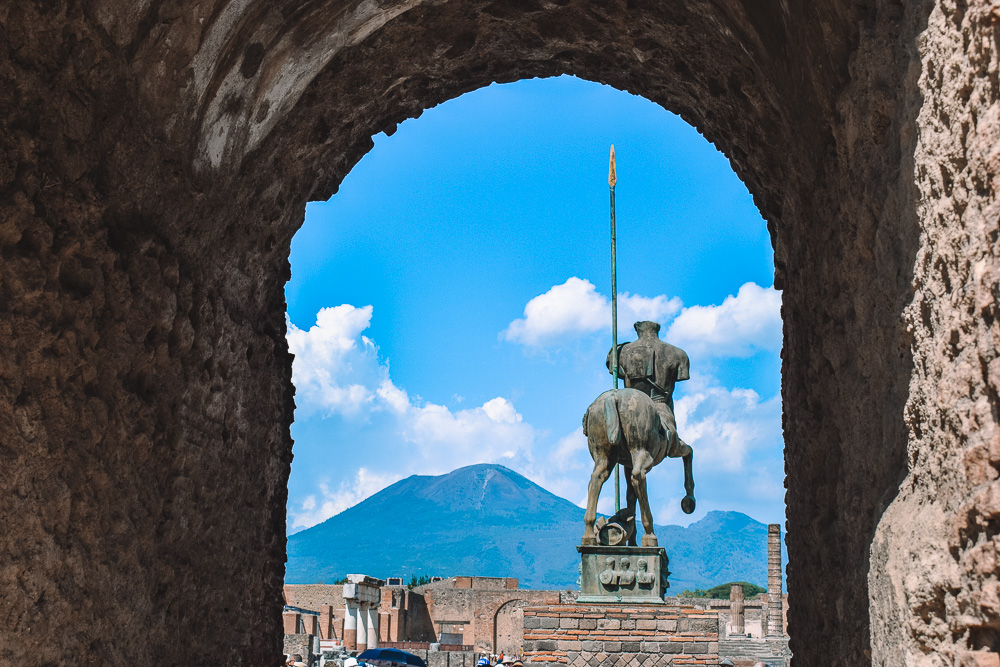
Unique views of Pompeii and Mount Vesuvius in Italy
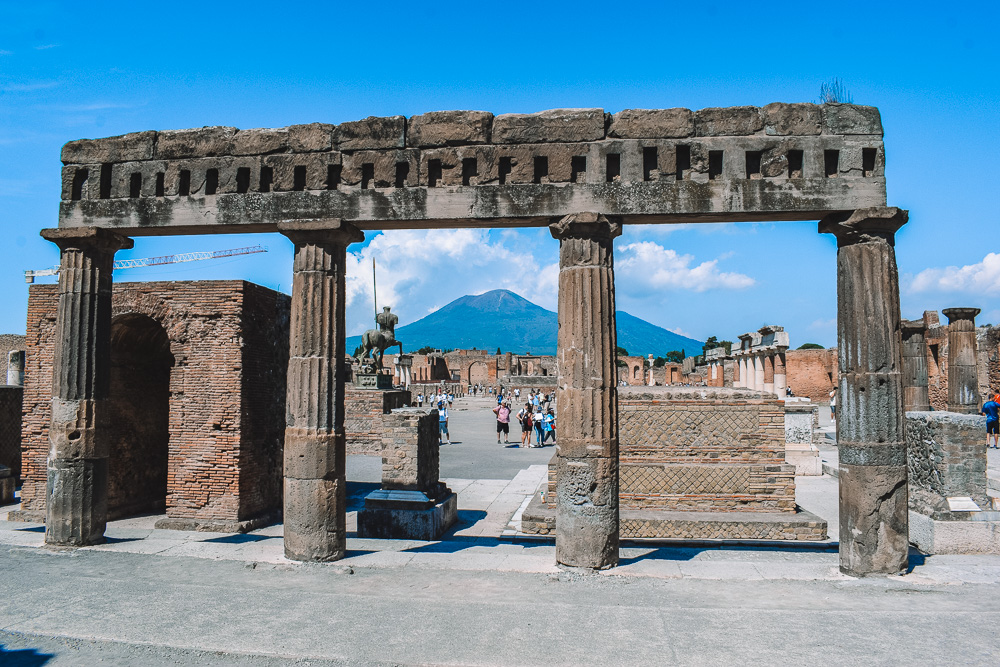
Columns of the Foro di Pompeii framing Mount Vesuvius in the background
What is Pompeii
The ruins of Pompeii are the remnants of a once-thriving Roman city located in the Bay of Naples in southern Italy. This bustling trading port boasted a population of approximately 20,000 residents.
It was a fully developed city equipped with an amphitheater, a forum, baths, temples, and public fountains, complete with holiday villas in the suburbs.
However, in 79 AD, the nearby Mount Vesuvius erupted, unleashing a catastrophic event that blanketed the area in volcanic ash and pumice. Temperatures soared to an astonishing 300 degrees.
Those who did not escape were ultimately killed and entombed under six meters of ash, entirely obliterating the city. Roman historian Pliny the Younger wrote extensively about this event.
Fast forward to 1594 when architect Domenico Fontana accidentally unearthed the ruins during excavations.
In 1748, systematic excavations began, and today Pompeii is a UNESCO World Heritage Site. Remarkably, new discoveries continue to be made here.
It’s a must-visit on many Italy itineraries and bucket lists, and it’s easy to understand why.
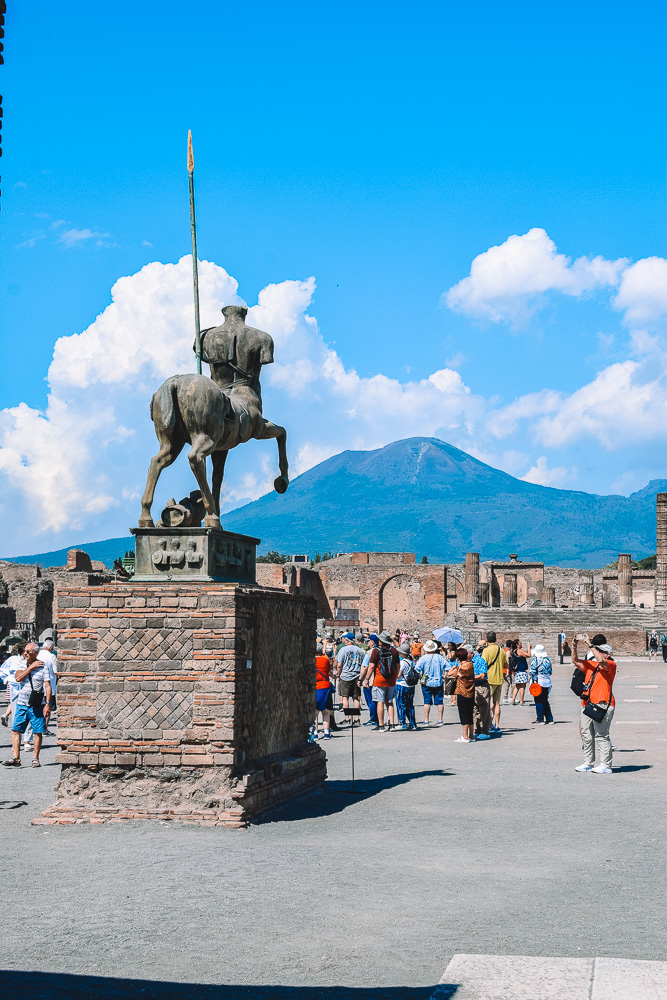
View of the Centauro di Igor Mitoraj, the Foro di Pompeii and Mount Vesuvius in the background
Can you visit Pompeii without a tour?
Yes, you can explore Pompeii independently, as I did on my last visit.
However, I must say that having a local guide would significantly enhance your experience. They can lead you to the most important ruins and provide fascinating insights about them.
A knowledgeable guide will share historical facts and anecdotes that you might miss otherwise and introduce you to some lesser-known sites.
Considering the vast size of the archaeological site (still being excavated), venturing in without any prior knowledge is not advisable.
Otherwise, you may find yourself aimlessly roaming the 170-acre expanse, missing out on the highlights, which is essentially what I did.
Click here to book your guided tour of Pompeii!
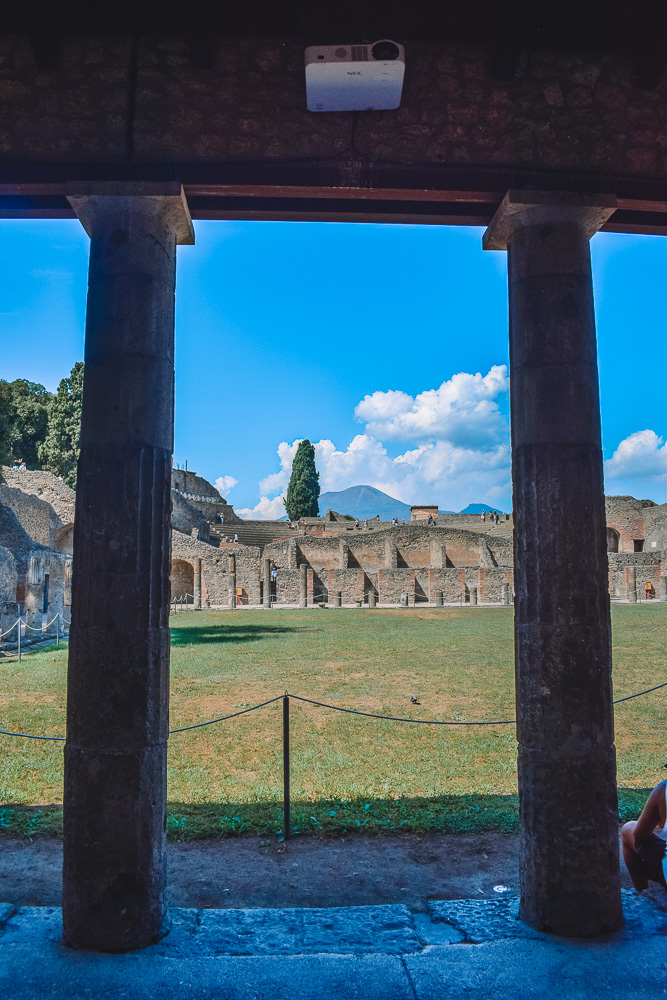
Mount Vesuvius as seen from the Gladiator Barrack’s of Pompeii
Upon entering Pompeii and realizing just how vast it is, we found ourselves wandering aimlessly, seeking refuge from the intense Italian summer heat under the shade of ancient Roman columns while trying to Google the best places to visit.
Don’t follow our example; instead, book yourself a guided tour around Pompeii with an archaeologist to make your experience smoother.
That said, it’s still possible to enjoy a self-guided tour of Pompeii, as we did, and it turned out to be quite an enjoyable day.
If you’re curious about the best ruins to include in your DIY walking tour of this ancient site, here’s what you should see in the Pompeii ruins.
Don’t miss out! Check out prices & availability for your Pompeii tour with an archaeologist here!
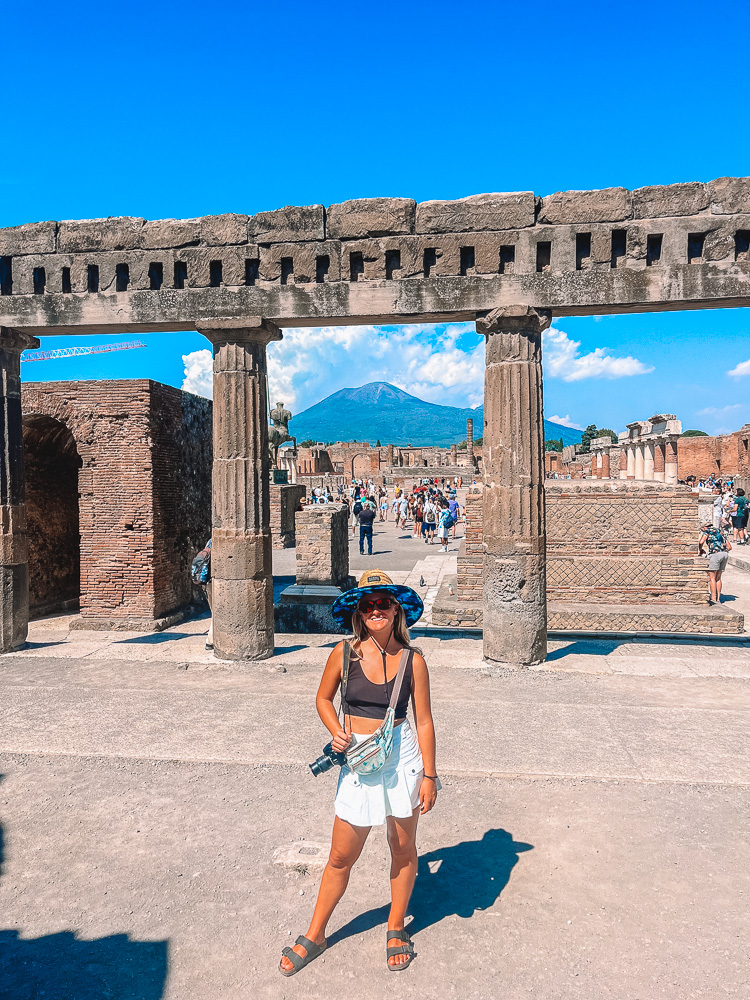
Tourist mode on while exploring Pompeii in Italy
Map of Pompeii Ruins
Before delving into the details of the most significant ruins in Pompeii, it’s helpful to reference a map of the archaeological site.
The Pompeii site encompasses 163 acres and contains numerous ruins within it. I’ve marked the best-preserved, most interesting, or historically significant ruins in the map below.
I’ve also indicated Parking Zeus and the Porta Marina entrance in yellow, making it easier to identify where to start your self-guided tour of Pompeii.
What to See in Pompeii
Here are some top attractions to include during your DIY visit to this remarkable relic of ancient Rome.
Park at Parking Zeus & Start at Porta Marina
I recommend starting your visit at Parking Zeus before heading to the nearest entrance. Purchase your tickets at the official entrance gates (avoid the sellers outside!), or buy them online in advance.
During the short walk from Parking Zeus to the Pompeii Entrance, you’ll encounter at least two unofficial ticket vendors.
While they may offer entry, these tickets are not official and typically cost an additional 2-3 EUR over the official Pompeii ticket price.
At the main entrance and official ticket office, you can also collect a map of the Pompeii ruins and hire a guide if you’d prefer not to explore alone.
After passing through the ticket entrance, you’ll enter through Porta Marina and officially step into the Pompeii archaeological park.
Skip the line and book your Pompeii fast-track ticket here!
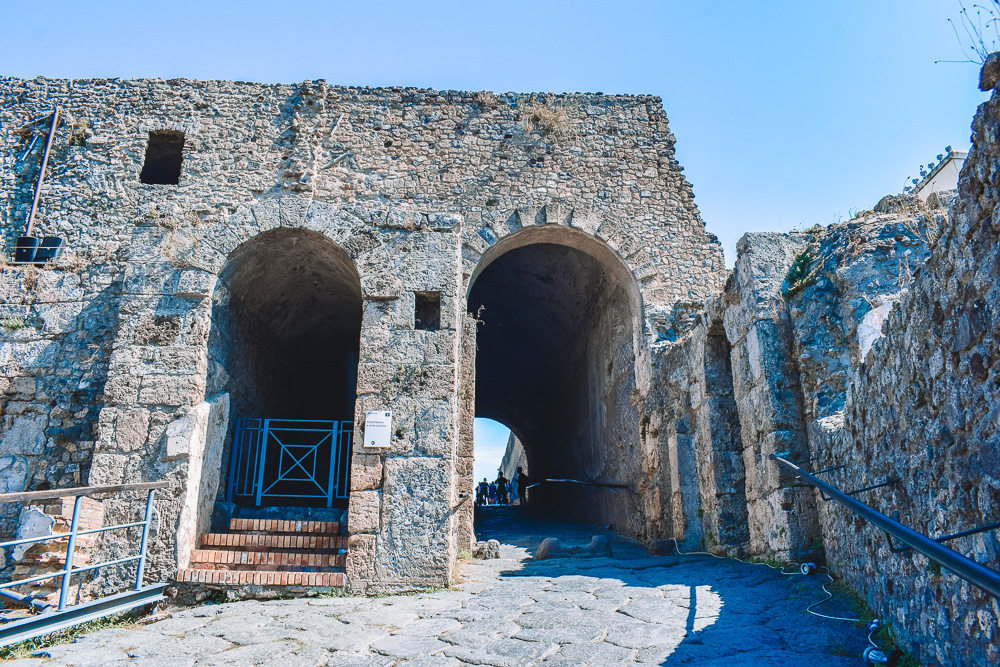
Entering the archaeological site of Pompeii from Porta Marina
Sanctuary of Apollo
Begin your itinerary at the Temple of Apollo, a key site dating back to 120 BC and dedicated to the Roman deity, Apollo. This temple is one of the oldest religious structures in Pompeii.
Evidence suggests that temples have existed at this location since the 6th century BC.
Its strategic position on the route leading to the Marina Gate, which was the entrance to the center of the city, adds to its significance.
Currently, not much remains except for a few standing columns along with steps and wall ruins. You can easily see Mount Vesuvius from this site.
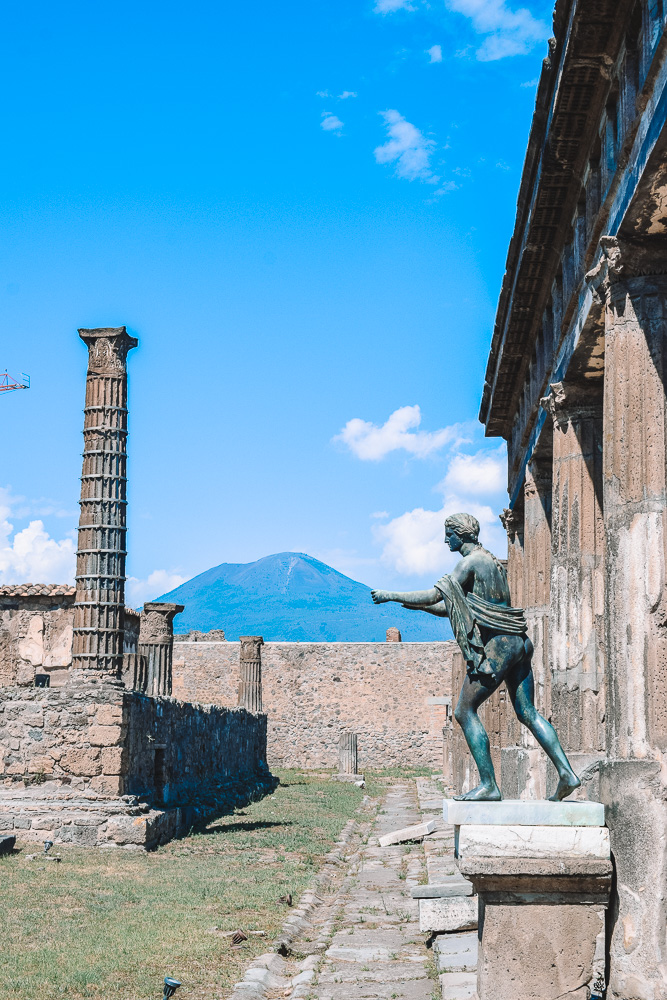
The Santuario di Apollo in Pompeii with Mount Vesuvius in the background
Foro di Pompeii
Nearby is the Foro di Pompeii, or the Forum. This area is a highlight of Pompeii, renowned for its historical importance.
The Forum was once the heart of public life in the city, hosting markets, administrative activities, speeches, and festivals.
Important buildings, such as bathhouses, theatres, and a basilica, would have once adorned the Forum.
Renovated between the 3rd and 2nd centuries BC, the Forum features new paving slabs and porticoes. Standing here today allows you to envision the lively gatherings of the Pompeii residents.
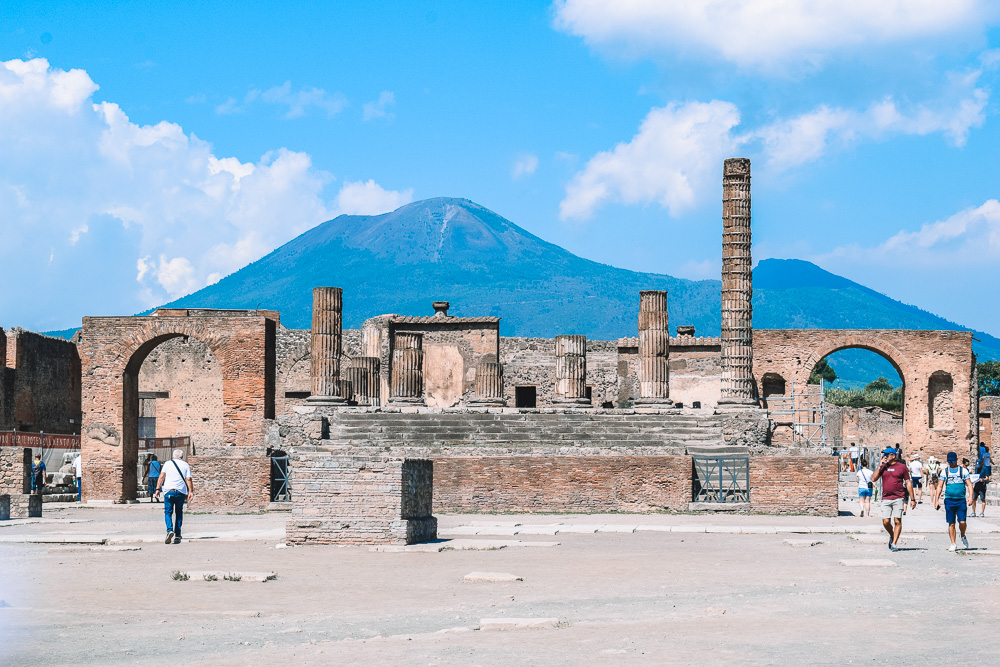
The Foro di Pompeii with Mount Vesuvius in the background
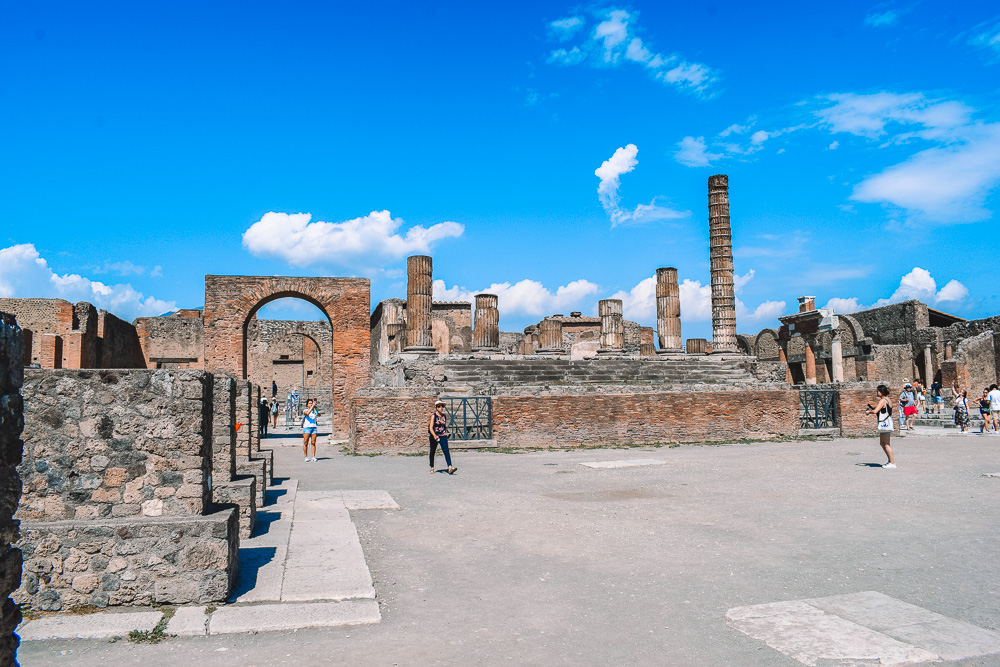
Exploring the Foro di Pompeii
House of the Faun
Next on your ruins map is the House of the Faun, one of the most popular sites in Pompeii.
This luxurious villa dates back to the 2nd century BC and spans an area of 3,000 square meters.
Although it lies in ruins now, remnants of its grandeur remain, showcasing its vast layout.
Numerous significant artworks were discovered here, now housed in the National Archaeological Museum of Naples.
In the villa’s center, you’ll find a replica of the faun statue that gives the house its name (a half-human, half-goat creature).
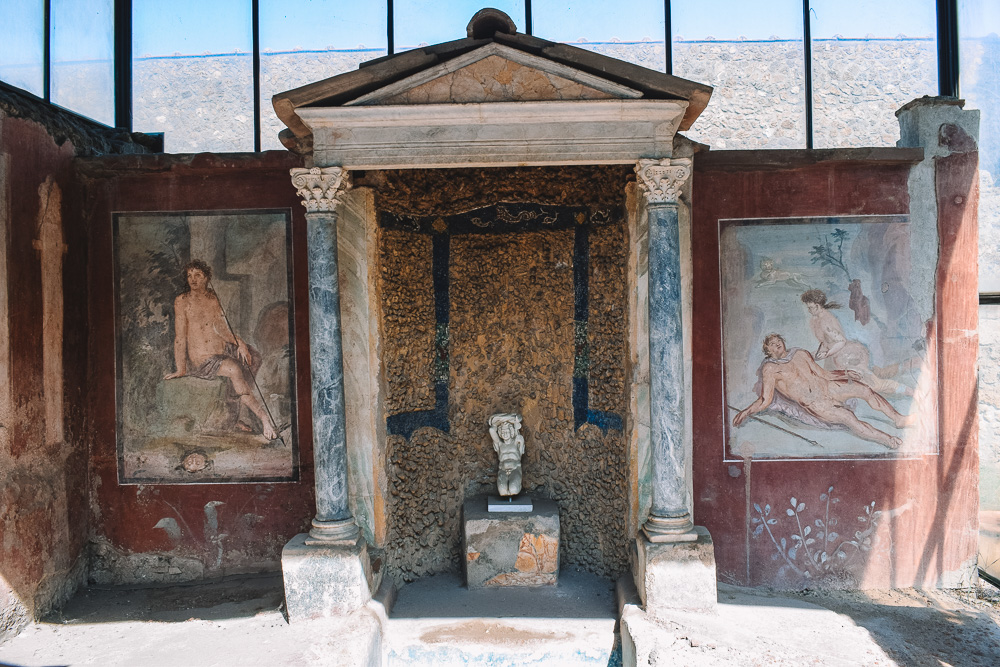
Some of the beautiful affresco paintings in Pompei
Lupanare di Pompeii
One of the most notorious sites in Pompeii is the Lupanare, or brothel, located just a couple of blocks from the Forum.
Given Pompeii’s close association with Venus, the Roman goddess of love and sexuality, the city once housed many brothels.
This particular establishment was the largest, featuring 10 rooms furnished simply with a mattress on a raised brick platform.
One fascinating aspect is the wall paintings and erotic art that adorn its walls. Since Pompeii was a nautical city with ships arriving from various Mediterranean locations, not all sailors spoke Latin. Thus, the walls of brothels were covered with erotic images, allowing sailors to indicate the services they desired.
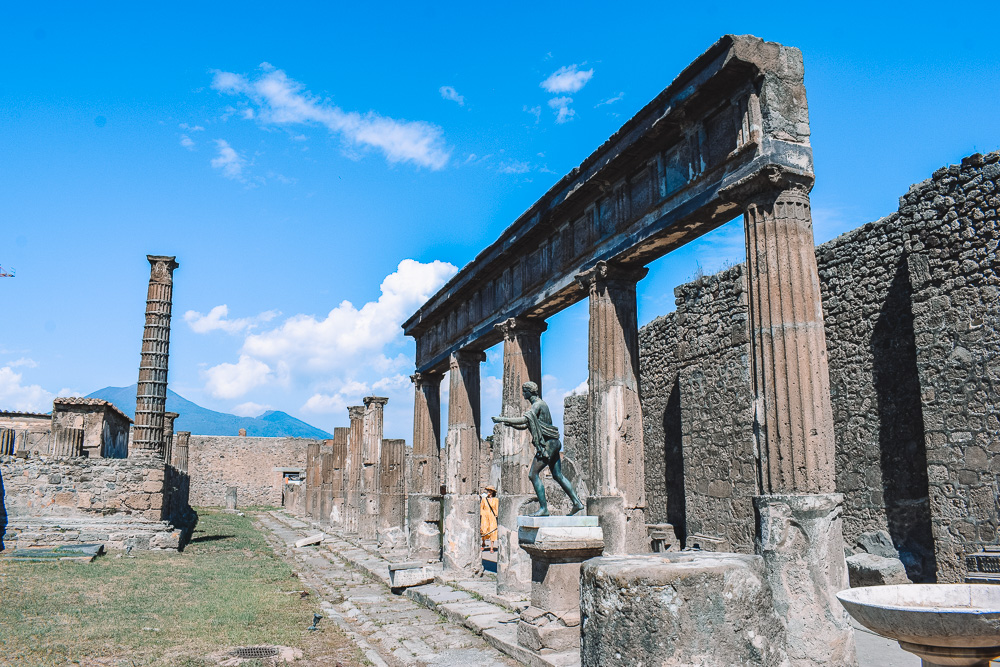
Exploring the Santuario di Apollo in Pompeii, Italy
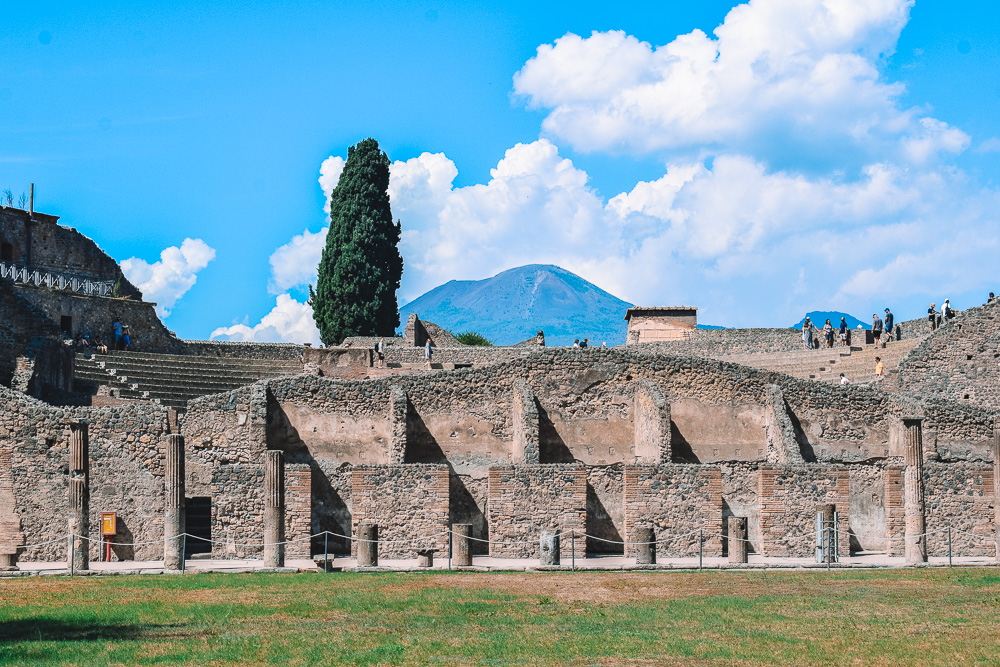
Exploring the Gladiator Barracks at the Quadriportico dei Teatri in Pompeii, with Mount Vesuvius in the background
Terme Stabiane
Close to the Lupanare lies the impressive Terme Stabiane, the largest and oldest of the five bath complexes that once existed in Pompeii.
Dating back to 125 BC, the Stabian Baths are among the oldest surviving examples of ancient public baths.
Various areas can still be identified today, including changing rooms, the tepidarium, the frigidarium, and caldarium.
There’s even a remaining swimming pool, and you can still see the signs for the entrances designated for men and women.
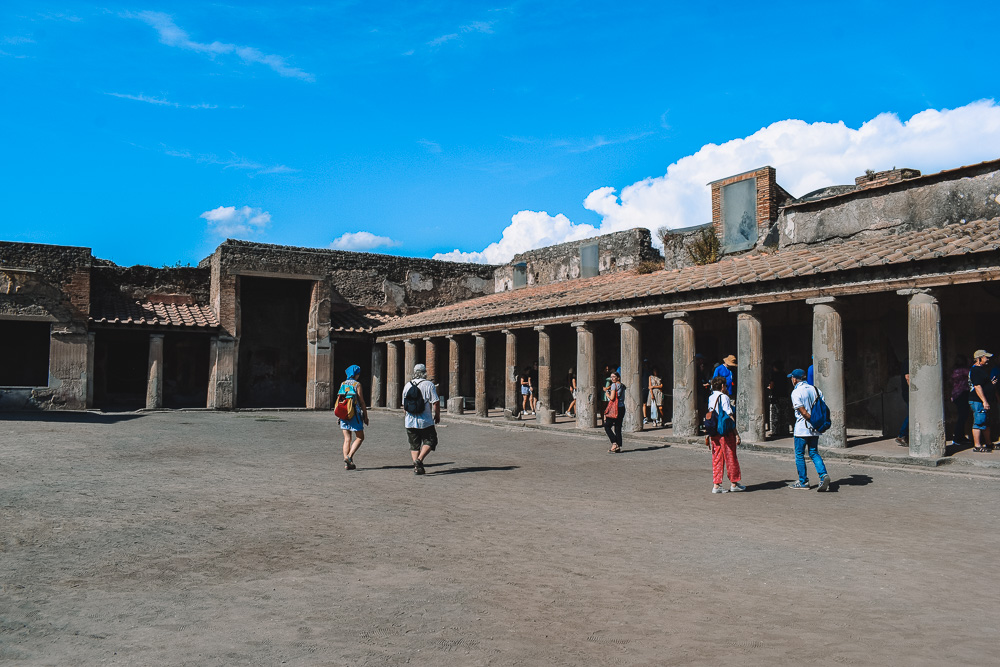
The Terme Stabiane in Pompeii, Italy
Teatro Grande
The Theatre of Pompeii stands as the largest theatre in the city. Constructed in the 2nd century BC, it could accommodate around 5,000 spectators.
Interestingly, it was the first stone theatre ever built in the Roman world, making it one of the highlights of Pompeii. It represents an essential piece of theatre history.
The complex also includes the Odeon, a smaller theatre built in 80 BC with a capacity of approximately 1,500. Don’t miss the Quadriporticus, which was used by the audience to move between events.
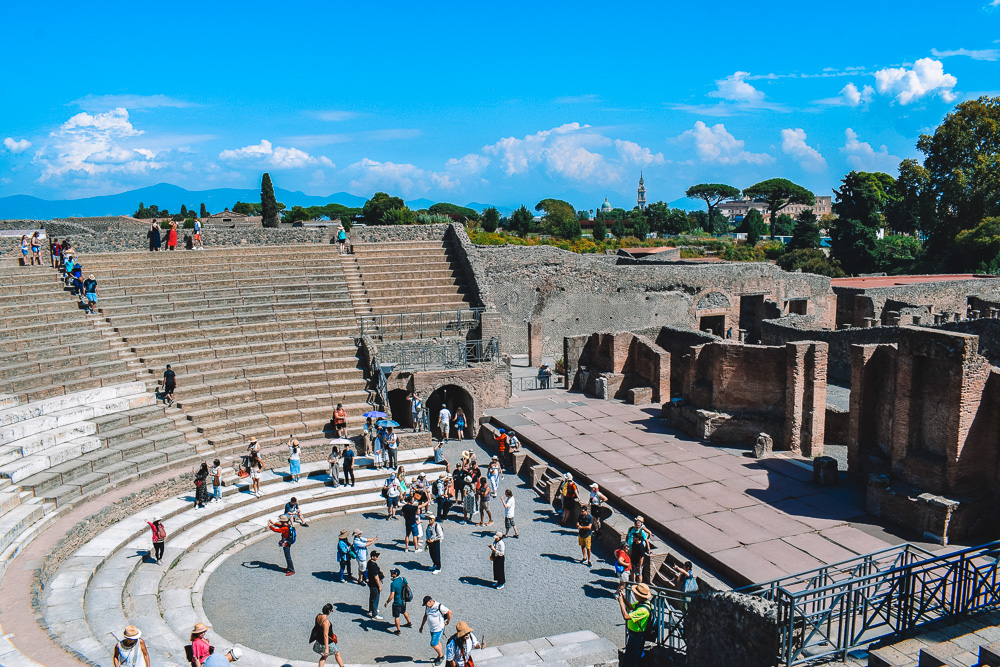
Exploring the Teatro Grande of Pompeii
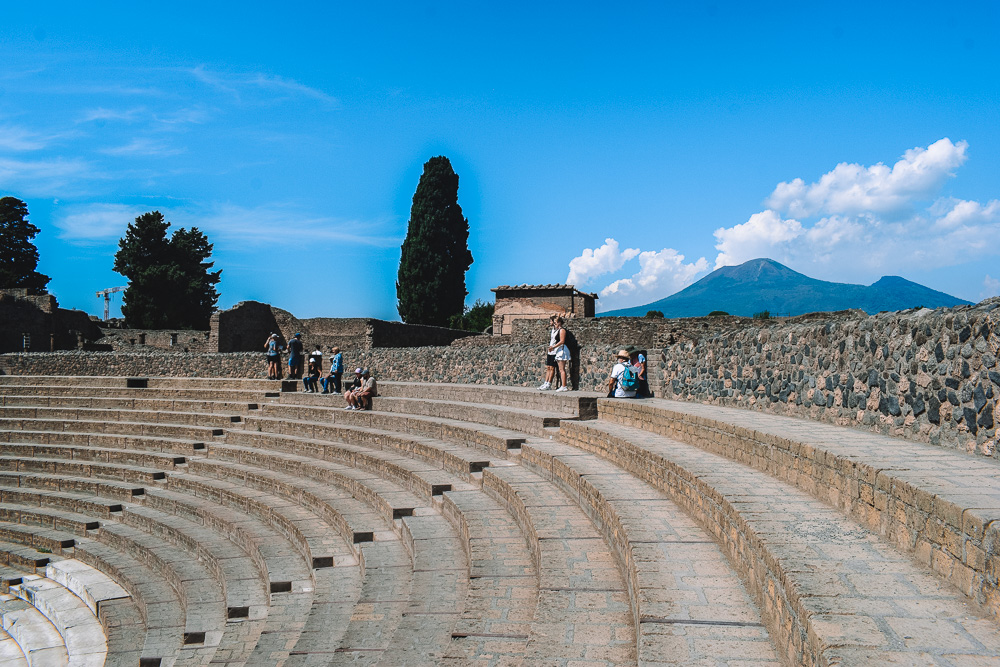
Exploring the Teatro Grande of Pompeii with Mount Vesuvius in the background
Gladiator Barracks
The Gladiator Barracks were the hub of gladiatorial life in Pompeii. This facility served as a training ground for gladiators and includes a Quadriporticus similar to the Teatro Grande.
Numerous inscriptions adorn the walls, depicting both everyday life for gladiators as well as mythological and hunting scenes.
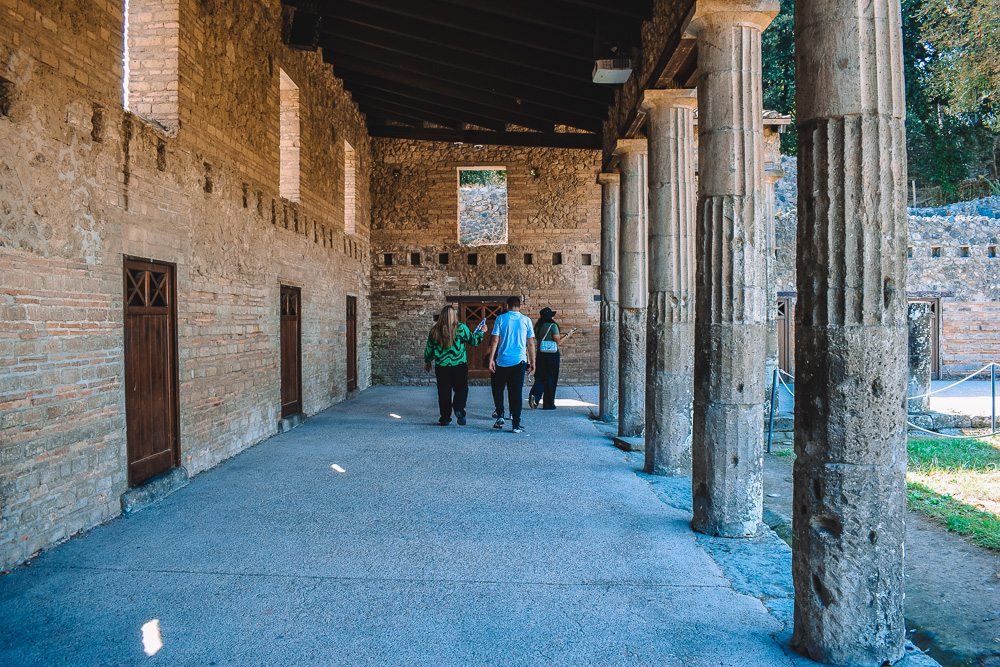
Exploring the Gladiator Barracks at the Quadriportico dei Teatri in Pompeii
House of Menander
The House of Menander provides insight into the lifestyle of Pompeii’s elite citizens. Once a residence for a wealthy family, this impressive townhouse spans 1,800 square meters.
The house itself showcases luxury, with Corinthian columns, gardens, and exquisite frescoes.
Interestingly, renovations were underway at the time of Mount Vesuvius’s eruption.
Archaeologists know this because valuable items like silverware were in storage, and only a few household staff were present during the disaster.
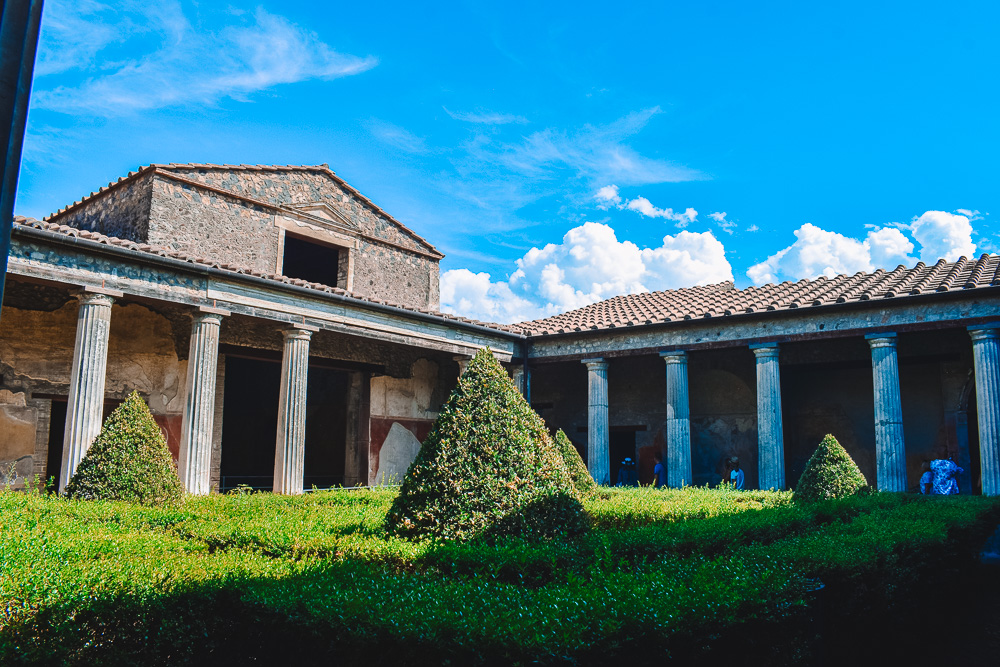
The beautiful courtyard of House of Menander in Pompeii, Italy
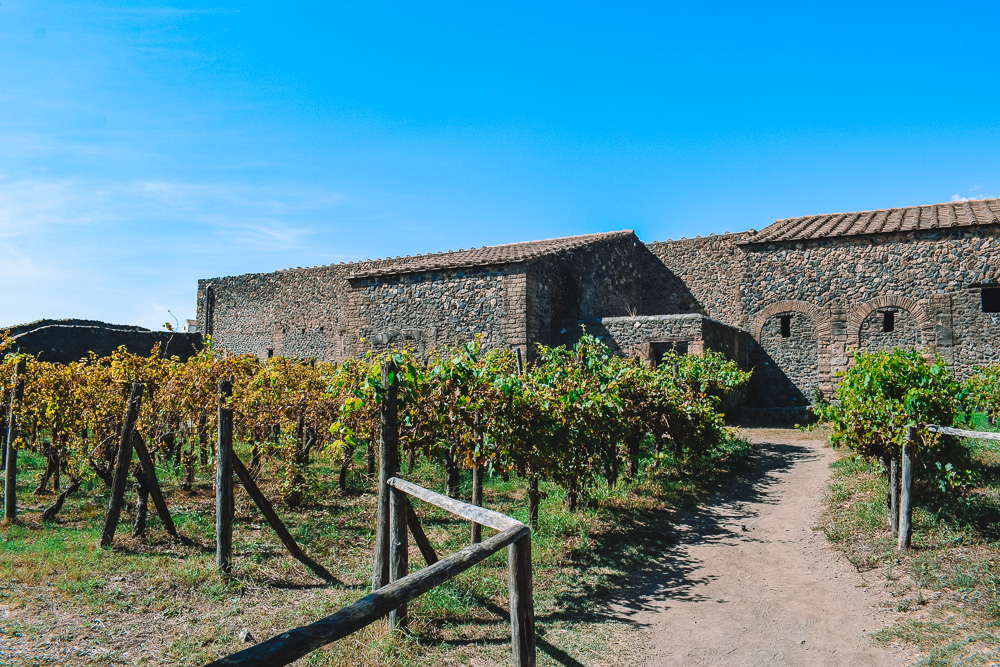
The vineyard of House of Menander in Pompeii, Italy
House of Ceii
It is believed that the House of Ceii belonged to a wealthy magistrate named Lucius Ceius Secundus. Although smaller than the House of Menander or the Casa del Fauno, it remains lavishly decorated.
In the garden, you can admire striking frescoes depicting landscapes, hunting scenes, Egyptian themes (including a portrayal of the River Nile), and various wild beasts.
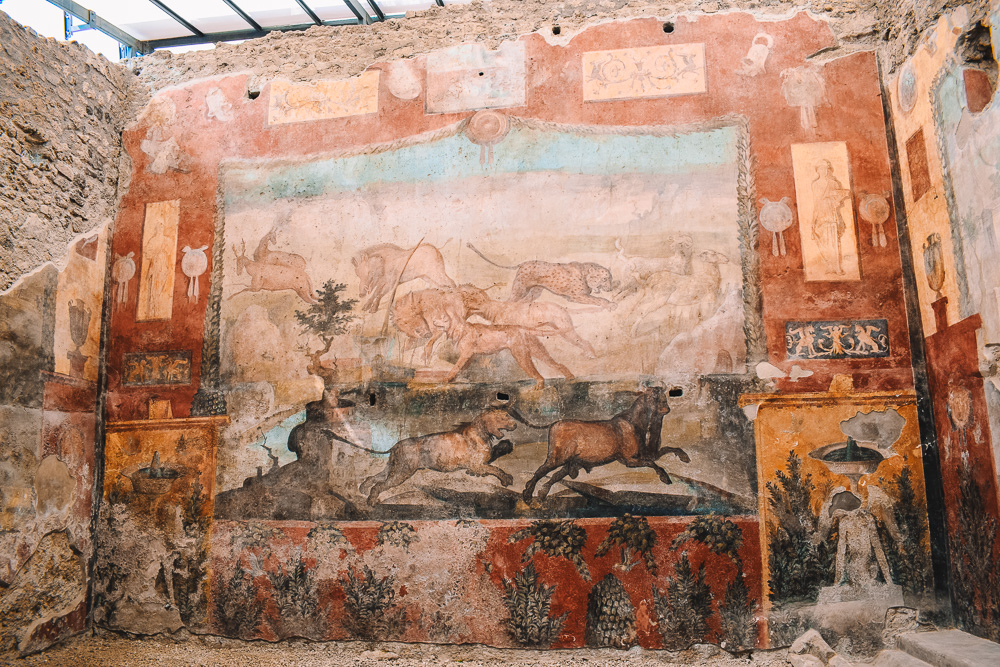
The beautiful paintings and affrescos of Casa dei Ceii in Pompeii, Italy
Garden of the Fugitives
The Garden of the Fugitives is a significant site where you can witness the final moments of 13 tragic inhabitants who perished while trying to escape the devastating eruption.
Originally part of a vineyard where people gathered for banquets, the glass-encased casts of these 13 victims can be observed near the back wall of the garden.
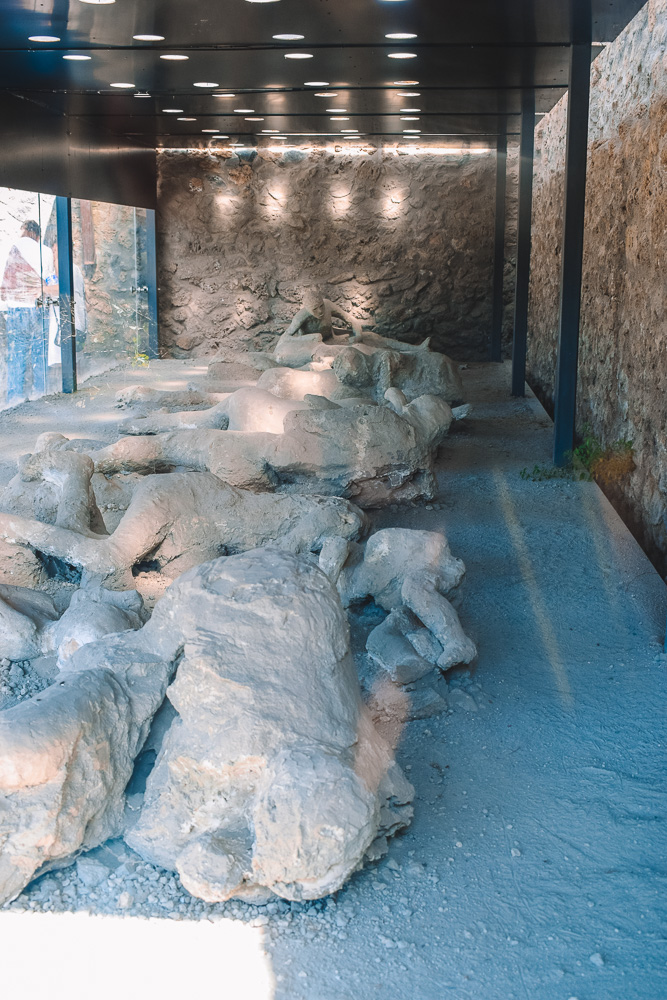
The Garden of the Fugitives in Pompeii, Italy
Amphitheatre of Pompeii
Dating back to 70 BC, the Amphitheatre of Pompeii holds the title of the oldest surviving Roman amphitheater, making it one of the most significant relics of the ancient Roman Empire.
It hosted gladiatorial contests and large-scale sporting events, once accommodating about 20,000 spectators within its walls. Built partly into the surrounding earth, it stands out as a remarkable example of ancient architecture.
Posters and murals around the amphitheater provide intriguing insights into the events that took place, with one reading “Heart-throb of the Girls,” reflecting the pop culture of Pompeii during that time.
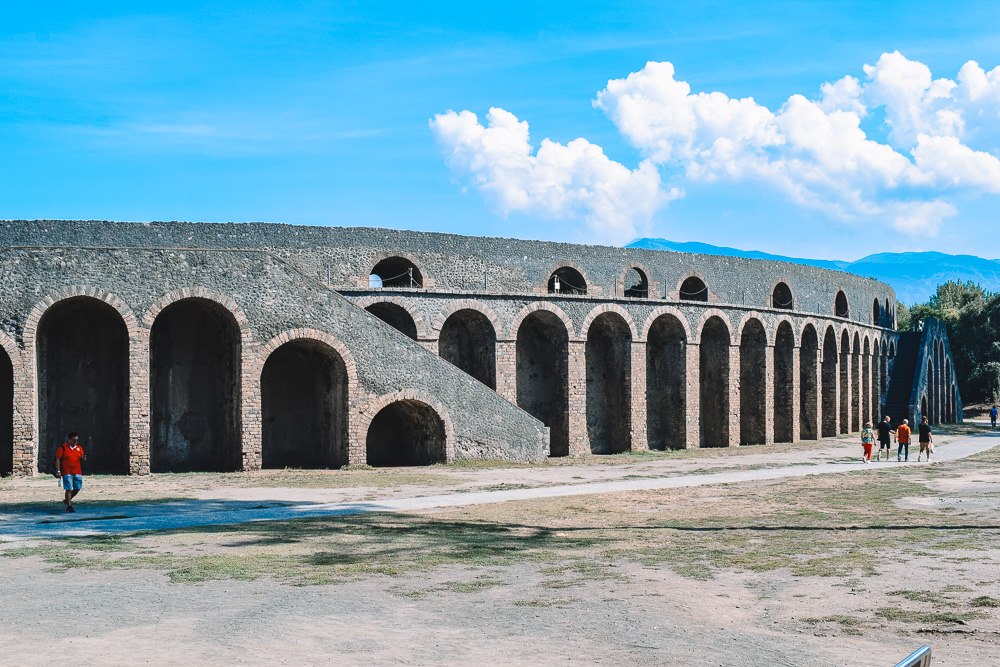
The Amphitheatre of Pompeii from the outside
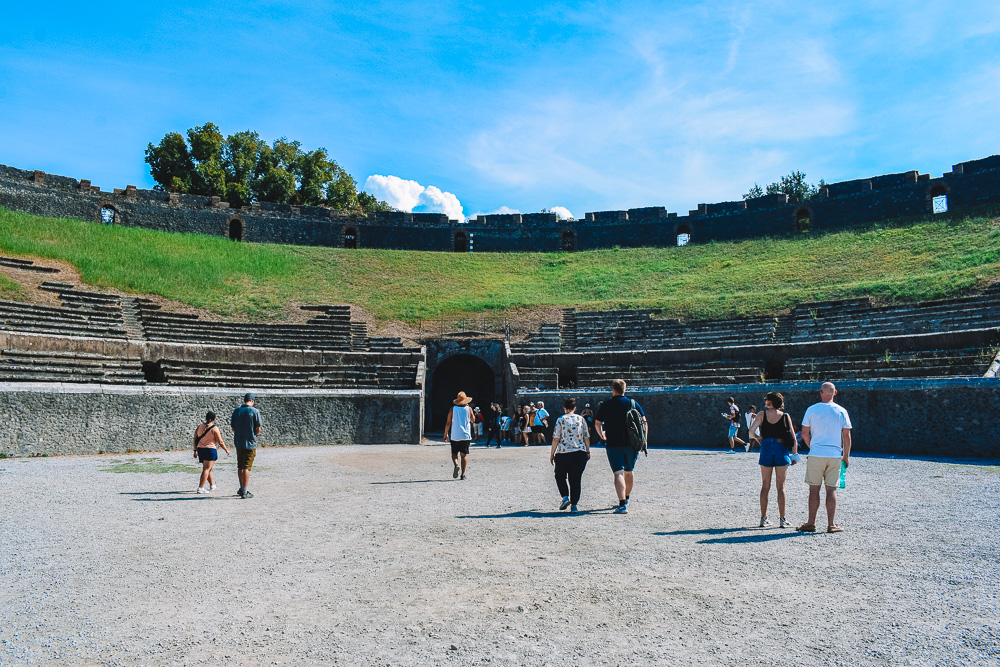
The interior of the Amphitheatre of Pompeii in Italy
House of Venus in the Shell
This first-century BC house underwent many redesigns but is celebrated for the monumental fresco that embellishes one of its walls.
The artwork depicts Venus, the goddess, reclining in a giant shell, adorned with jewelry and a tiara.
This home belonged to a prominent family named the Satrii, influential during the latter days of Pompeii.
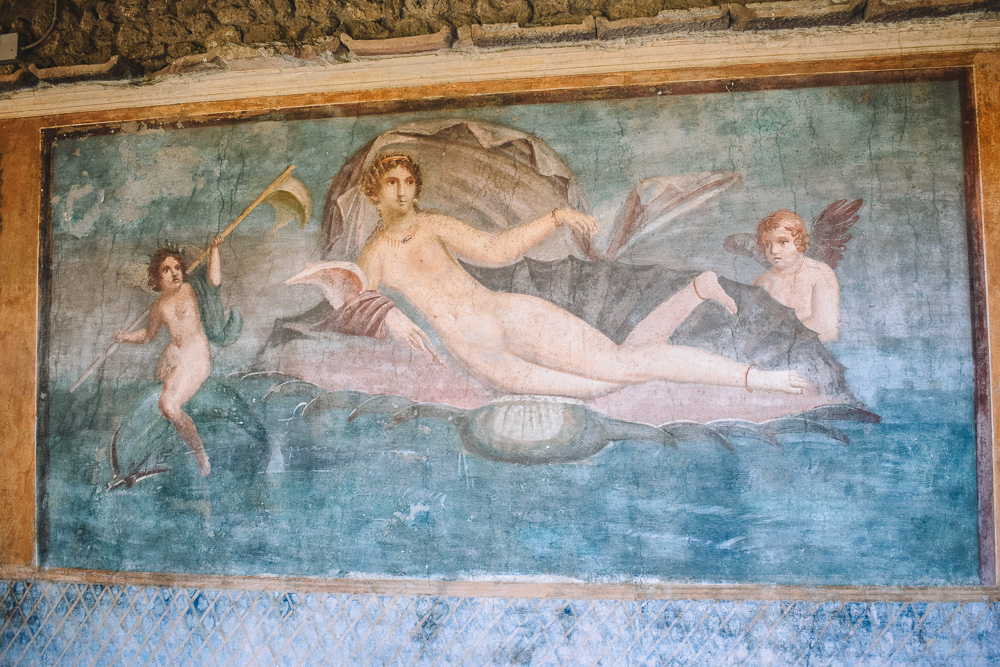
The beautiful affresco from which House of Venus in the Shell takes its name, in Pompeii, Italy
Best Pompeii Tours
If exploring Pompeii independently seems overwhelming after reviewing my map and this article, here are some excellent tours to consider joining.
Pompeii: Small Group Tour with an Archaeologist – Ideal for those planning to reach Pompeii independently and looking for an experienced guide to navigate the archaeological site.
Naples or Sorrento: Full-Day Pompeii and Mount Vesuvius Tour – Perfect for those staying in Naples or Sorrento, this tour includes transfers and a visit to Mount Vesuvius.
From Rome: Pompeii and Mount Vesuvius Day Trip – If your itinerary only allows for a day trip from Rome, this tour is the best way to experience Pompeii.
Amalfi Coast: Pompeii, Vesuvius, & Wine Tasting with Lunch – In addition to transfers from/to the Amalfi Coast, this guided tour includes a visit to Mount Vesuvius, lunch, and a wine tasting! What else could you want?
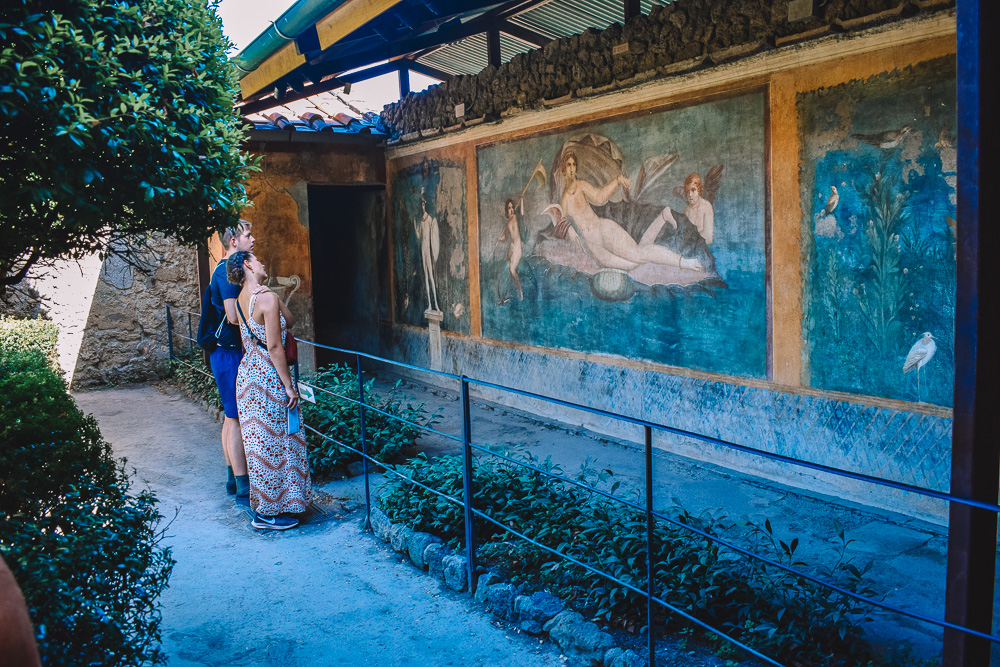
Admiring the beautiful murals at the House of Venus in the Shell in Pompeii, Italy
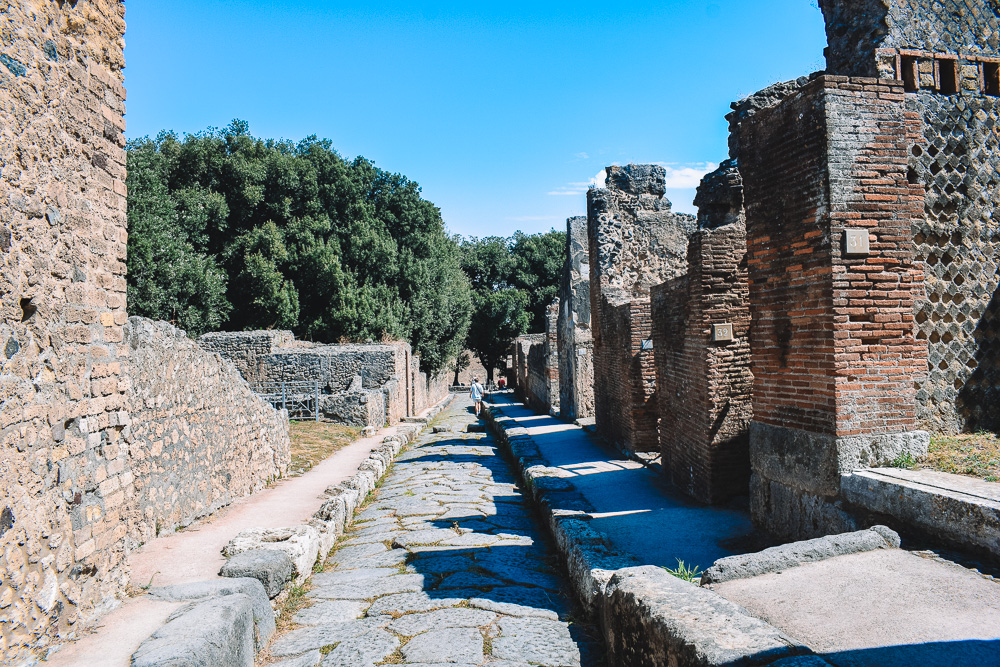
Walking down the ancient streets of Pompeii in Italy
Where to Stay for a Visit to Pompeii
Although Naples is closer, I personally recommend staying on the Amalfi Coast for your Pompeii day trip.
It’s roughly an hour’s drive and a truly breathtaking region of Italy. This way, you can create an itinerary that includes visits to stunning spots like Capri and Positano.
Here are some accommodation options to suit every budget.
Budget: Holidays Baia D’Amalfi – While budget options on the Amalfi Coast can be rare, this hotel offers affordable rates and is conveniently located by the harbor.
Click here to book your stay at Holidays Baia D’Amalfi!
Mid-range: Albergo S. Andrea – Offering beautiful views of the Amalfi Cathedral, this is a great choice for an affordable stay.
Check out prices & availability at Albergo S. Andrea in Amalfi here!
Luxury: Le Sirenuse – This is the epitome of luxury accommodation in Positano. With stunning design, flawless service, and breathtaking views, it’s the perfect place to indulge yourself.
Click here to book your stay at Le Sirenuse in Positano!
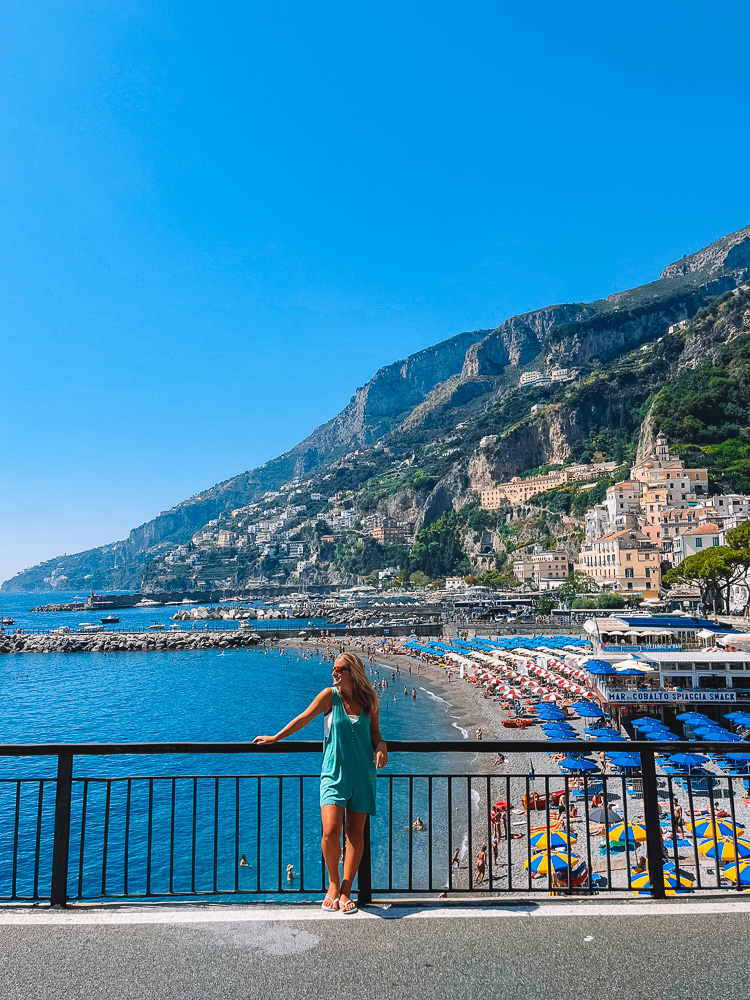
Enjoying the beach, sunshine and views in Amalfi, Italy
What to Pack for Pompeii
While you don’t need much beyond the usual travel essentials, here’s a list of items I highly recommend bringing along for your visit to Pompeii.
Refillable water bottle – There are drinking fountains available in Pompeii, so be sure to pack a refillable bottle. The summer heat can be intense, and staying hydrated is crucial.
Hat – If you plan a summer visit, a hat is a must due to the intense sun and lack of shade.
Sunblock/sunscreen – Given the minimal shade, protecting your skin with sunblock is essential to avoid sunburn.
Sturdy, comfortable shoes – With extensive walking required over uneven, cobbled roads, wearing comfortable footwear is vital. Hiking sandals are an excellent choice, if preferred.
Guidebook – If you opt for a self-guided tour, bringing a relevant guidebook will help you appreciate the sites you encounter.
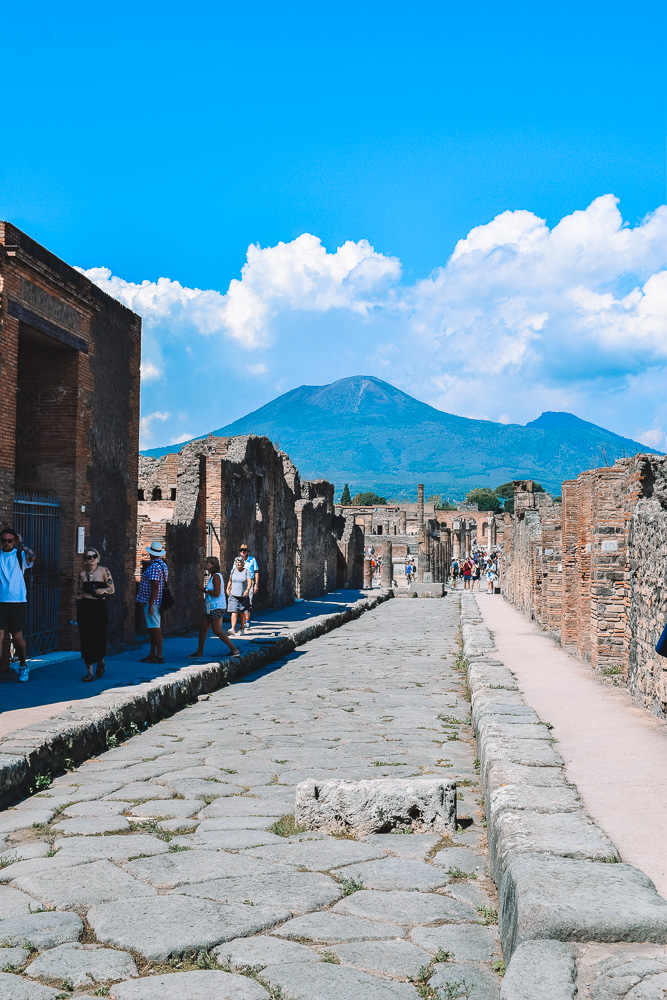
Walking down the cobbled streets of Pompeii, Italy
Do You Need Travel Insurance to Visit Pompeii?
Based on my past experience of spending two nights in a hospital in Tenerife that I had to pay for out of pocket (which wasn’t cheap), I always recommend obtaining travel insurance.
While you may not need it, it provides peace of mind for a small fee. Personally, I suggest purchasing your Italy travel insurance with Heymondo.
Heymondo offers customized travel insurance, ensuring the best value for your specific trip. You can also buy it even after arriving abroad if you forget to secure it before flying (which, if you’re anything like me, is a real possibility).
In addition to standard coverage for cancellations, medical expenses, and luggage loss, Heymondo provides 24/7 doctor chat and instant assistance through their app.
As a reader of Greta’s Travels, you can enjoy a 5% discount on your Heymondo travel insurance!
Click here to get 5% off your Heymondo travel insurance!
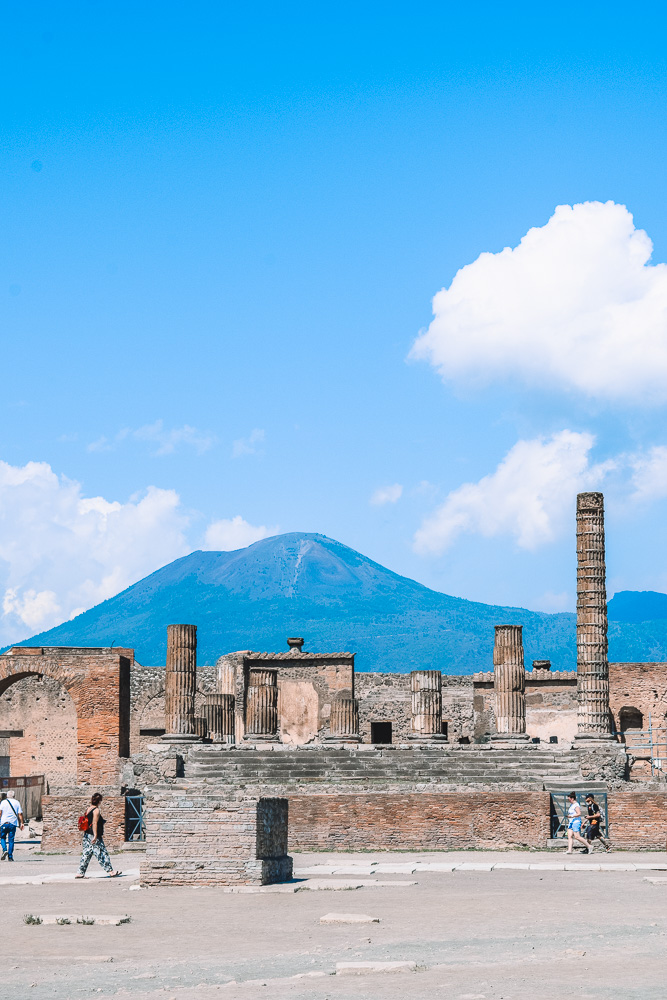
The Foro di Pompeii with Mount Vesuvius in the background
Final Thoughts on What to Do in Pompeii
That wraps up the ultimate guide on what to see in Pompeii! Have you ever visited Pompeii before? What were your thoughts? I’d love to know in the comments below!
This marked my third visit to Pompeii, and it was the time I appreciated it the most. I had previously visited on a school trip as a kid and again on a family trip during my teenage years.
While I didn’t dislike those experiences, I certainly did not grasp the sheer vastness and significance of this unique historical site. It’s not every day you get to explore such a well-preserved Ancient Roman city!
Along with our private sunset boat tour in Positano, hiking the Path of the Gods, and our boat trip in Capri, it was easily one of the highlights of our time on the Amalfi Coast.
Pompeii may not enjoy the same buzz as other Italian destinations like Lake Como, Cinque Terre, Florence, Matera, or Venice, but it is indeed a remarkable and unforgettable place.
I hope you found my guide to Pompeii helpful and that it has aided you in planning what to see. If you have any questions, feel free to ask in the comments!
Enjoyed reading about the best ruins to see in Pompeii? Pin it!
